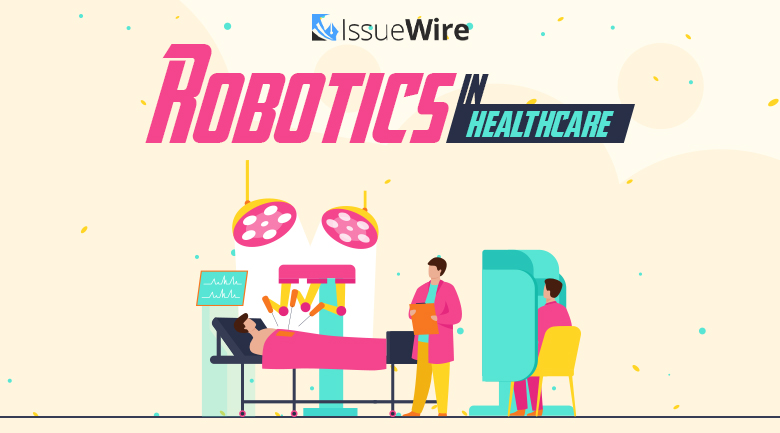Healthcare has been seen as a promising space for robotics and automation in the last 50 years. Since 1974 medical researchers have been looking for robotics and its usages in this sphere. In medical applications, the implementation of robotics has often been suggested for many reasons. It is quite shocking- although the proposal was made a few decades back, the process moves slowly towards its implementation.
Although there were a lot of hypes in the media and television, only a few robots are used in the healthcare sector. However, it has picked up the pace in the past few years. Robotics is now slowly making its way to the operation theatres also.
What was the reason for the slow uptake of robotics in the healthcare sector?
The da Vinci Surgical System has often been shown as a sign of rapid uptake of robotics in the healthcare sector. However, it is relatively slow.
Robotic surgery has become famous in the 1980s. The doctors call it robot-assisted surgery. The first surgery was performed by Puma 650 robot in 1985. It was used to improve the neurosurgical biopsies. However, there had been only a few surgeries performed by robots by 2010 and only 1431 hospitals in the world had a da, Vinci.
The slow uptake was caused by the ignorance of the Government in approving the use of robots in surgical tasks in hospitals. The da Vinci was FDA approved in 200o and by 2014 it remained an FDA-approved surgical robot that can perform neck and head surgery.
However, things started changing in 2016. Almost 45% of the hospitals in the USA had a Vinci and 9 robots were approved for surgeries by FDA.
Cobots in the non-surgical healthcare:
The use of robotics in surgery is discussed more than anything in the healthcare sector. The other applications of robotics in the healthcare sector are telepresence, healthcare, prescription dispensing, rehabilitation, and transportation.
Today, medical personnel are interested more in collaborative robotics which in short is also known as Cobot application.
5 Ways cobots can be used in medicine and healthcare:
Modern robots are designed to fulfill their target applications, like packaging, manufacturing, and other purposes.
One can think that collaborative robots or Cobots are not perfect for medicine packaging and manufacturing. However, today in almost all activities robotics is used to make the process simpler and achieve the goal faster.
So, here are the 5 applications in which Cobots are used
1. Packaging of medical device
Packaging is a risk-free application to use robotics. Cobots are perfect for the task. When these devices are packages, a human touch can contaminate the kit. It is better to use cobots that can complete the packaging without contaminating the kit. However, the cobots also need to work in a sterile environment.
2. Lab automation:
Another task for which the cobots are proven highly beneficial in lab automation. A huge number of tasks are performed every day by labs. So, cobots are required in labs worldwide. As per the report of The British Medical Journal, 277 million tests were done in the UK alone.
The tests require some stages of the process to get the proper result. The lab in Copenhagen University Hospital requires testing 3000 blood samples every day. The university said that it added two UR robots to their labs to gain their productivity. Since then, though the workload has gained by 20%, they were able to give 90% reports within an hour.
3. Neurosurgery:
The previous two applications were not difficult for a robot to conduct. However, cobots are also used in surgical activities. A company called Synaptive Medical has made a product for neurosurgery that is completely cobot-based.
Before you think it wrongly, you must know cobots do not perform the surgery. It assists doctors by giving the best microscopic view to the neurosurgeons for the surgery. If the doctor wants to change the angle of the microscope during the surgery, the doctor does not need to do it physically. The software can do the changes for the doctors and set a perfect position for the doctor to complete the surgery more precisely.
4. The trendiest robots for therapeutic massage:
Well, it may look a little silly to you. Even, in the article, it was not required to mention this. However, therapeutic massage is an integral part of medical treatment. You need to know about this. In many massage centers, clinics, and hospitals; robots are used for therapeutic massage. There is a start-up called Massage Robotics in California that uses robotics to do full-body massages. The startup could not sustain itself for a long time as people did not feel any need for it.
5. Cobot in cutting bones:
In the previous case of neurosurgery, cobots do not perform the surgery physically. In this case, it does. The Carlo system involves cobots to conduct a laser bone ablation. Ablation is a process in which the part of the bones is cut away to stop its benign growth. Carlo is “the first medical tactile in the world that can cut bone without any contact and with cold laser technology.”
In healthcare, there is a need for robotics which needs to be addressed and accessed faster. Hope this article has helped you get the information about the usage of robotics in the surgical and nonsurgical healthcare sector.








